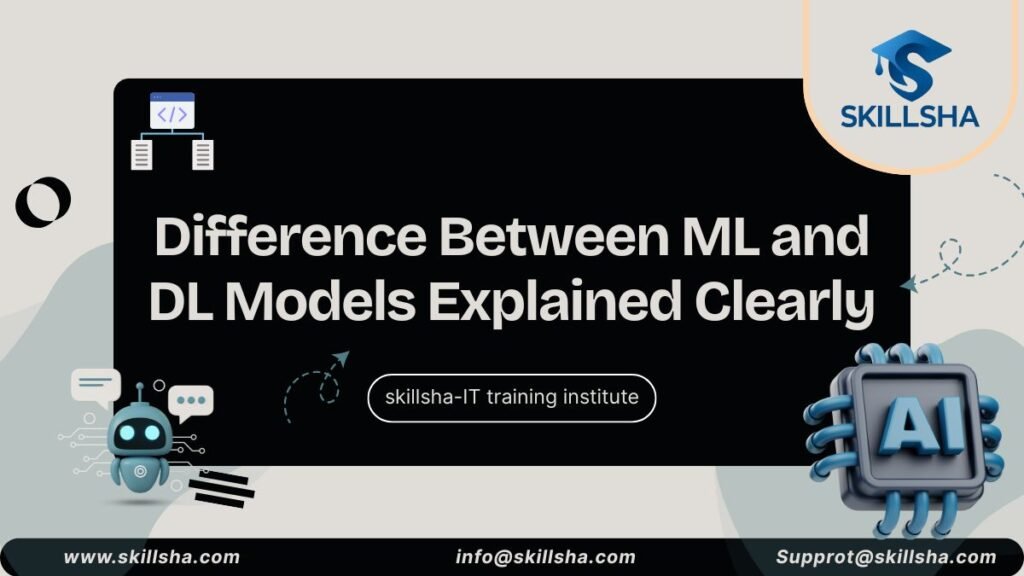Machine Learning (ML) and Deep Learning (DL) are two fundamental pillars of today’s artificial intelligence landscape. While people often mix them up, they actually represent quite different strategies for tackling predictive and classification challenges. Grasping these distinctions is essential for picking the right approach for your project or career path.
In this blog, we’ll cover:
– Clear definitions of ML and DL models
– Their structural and operational differences
– Strengths, limitations, and common applications
– Key factors to consider when choosing between them
And if you’re looking for hands-on, in-depth training in these fields, don’t miss Skillsha’s [Artificial Intelligence and Deep Learning] course in Uttar pradesh, which dives deep into both ML and DL models, complete with practical labs and industry-relevant projects.
Let’s jump in!
What Are Machine Learning (ML) Models?
Machine Learning is all about algorithms that learn from data patterns to make predictions or decisions without needing explicit programming. ML models use statistical techniques and can be broadly divided into:
– Supervised Learning: This involves training on labeled data to predict a known target. Examples include linear regression, decision trees, support vector machines, and k-nearest neighbors.
– Unsupervised Learning: This approach seeks to uncover structure in unlabeled data. Examples are k-means clustering, DBSCAN, and principal component analysis (PCA).
– Semi-supervised Learning: This method combines both labeled and unlabeled data for training.
– Reinforcement Learning: Here, agents learn through feedback based on rewards in a given environment.
Key components of ML models include:
– Feature engineering: The process of manually selecting and transforming input variables.
– Algorithms: These range from simple statistical methods like linear regression to more complex ones like random forests and gradient boosting machines.
– Performance metrics: Depending on the task, these can include accuracy, precision, recall, F1-score, and ROC-AUC.
What Is Deep Learning (DL) Models?
Deep Learning is a fascinating branch of Machine Learning (ML) that leverages artificial neural networks with multiple layers—hence the term “deep.” These networks are designed to automatically learn hierarchical representations from data.
Here are some key features of DL models:
– Neural network architecture: This includes input, multiple hidden, and output layers.
– Representation learning: There’s no need for explicit feature engineering; the model figures out the features directly from the raw data.
– Backpropagation and optimization: Essential training techniques like gradient descent and the Adam optimizer come into play here.
– High computational demands: These models often require GPUs and large datasets to function effectively.
Some popular DL architectures are:
– Convolutional Neural Networks (CNNs)—great for processing images and videos
– Recurrent Neural Networks (RNNs), including LSTM and GRU—ideal for handling sequences and language
– Transformers—leading the way in Natural Language Processing (NLP)
– Autoencoders and GANs (Generative Adversarial Networks)—used for various generative tasks
Structural and Operational Differences
| Aspect | Machine Learning (ML) Models | Deep Learning (DL) Models |
| Feature Engineering | Manual, domain-specific | Automatic through network layers |
| Model Complexity | Less complex, interpretable | Highly complex, often “black box” |
| Data Requirements | Works well with small to medium data | Requires large datasets |
| Computational Cost | Lower—can run on CPU | Higher—often requires GPU/TPU |
| Training Time | Generally faster | Can be significantly longer |
| Interpretability | Easier to interpret (e.g., tree structure) | Harder to interpret |
| Best for | Structured/tabular data | Unstructured data (images, audio, text) |
Use Cases: When to Choose Each
Machine Learning is Best For:
– Working with structured datasets like sales records, customer profiles, and sensor readings
– Situations where you need to interpret results—think credit scoring or compliance
– Smaller datasets where you can dive into complex feature engineering
– Tasks that need quicker development and lighter computing power
Deep Learning Excels With:
– Handling unstructured data such as images, videos, speech, and text
– Tackling complex pattern recognition tasks—like image segmentation or language translation
– Cases where predictive accuracy is more important than interpretability
– Large datasets and environments equipped with robust computational resources
Pros and Cons
ML Models
Advantages:
– Easy to interpret
– Quicker training times
– Less demanding on resources
– Works well with small datasets
Disadvantages:
– Needs manual feature engineering
– Struggles with highly complex patterns in unstructured data
DL Models
Advantages:
– Automatically learns features
– Great at recognizing intricate patterns
– Top-notch performance across various fields
Disadvantages:
– Requires massive amounts of data
– High costs and resource demands for training
– Can be tough to interpret and debug
Selecting Between ML and DL Models
Factors to Consider:
1. Data Volume & Type
– For tabular, small datasets → go with ML
– For image/audio/text and large datasets → choose DL
2. Interpretability Needs
– If transparency is crucial → ML is the way to go
– If accuracy is your top priority → DL is better
3. Compute Resources
– If you have modest resources → stick with ML
– If you have access to GPU/TPU → opt for DL
4. Project Timeline
– If you need quick iterations or deployment → ML is ideal
– If you’re aiming for research-grade precision → DL is the choice
5. Team Expertise
– If your team is familiar with statistics and simpler algorithms → ML is suitable
– If they have skills in neural networks and tuning deep architectures → DL is the better fit
6. Scalability Requirements
– When it comes to deploying models on lightweight devices like mobile phones or IoT gadgets that have limited power, machine learning (ML) tends to be the more practical choice.
– On the other hand, for large-scale enterprise systems that need to manage huge amounts of unstructured data, deep learning (DL) is the way to go.
7. Maintenance and Updates
– Generally speaking, ML models are a breeze to retrain, update, and keep in good shape over time.
– On the other hand, DL models can be quite a handful, often needing extensive retraining and racking up higher costs for updates because of their complexity.
Conclusion
The key differences between machine learning (ML) and deep learning (DL) models come down to their complexity, the methods they use, how interpretable they are, the resources they require, and how well they fit different types of data. ML is still a robust choice for many structured-data challenges, while DL really shines when it comes to tackling unstructured data tasks. The best approach for your project will depend on your specific needs, the data you have, the computing power at your disposal, and how much interpretability you require.
For anyone looking to build a strong foundation in both ML and DL through hands-on, instructor-led training, I highly recommend the [Artificial Intelligence and Deep Learning] course in UP offered by Skillsha. It covers both areas in depth, includes practical projects, and focuses on outcomes that are relevant to the industry.
Frequently Asked Questions (FAQ)
Q1: Can deep learning models work with small datasets?
Yes, they can, but they might not perform as well. Techniques like transfer learning, data augmentation, or using pre-trained models can help improve the performance of DL models on smaller datasets.
Q2: Are ML models always more interpretable than DL models?
Generally speaking, yes. Many ML models, such as decision trees, provide clear paths for decision-making. However, some ML models, like ensemble methods, can be less transparent. Tools for explainable AI, such as SHAP and LIME, can help address interpretability issues in both ML and DL.
Q3: What is transfer learning in DL?
Transfer learning is the process of starting with a pre-trained model (one that has been trained on a large dataset) and then fine-tuning it for your specific task. This approach can save time during training and often leads to high performance, even with smaller datasets.
Q4: Do I need GPUs for deep learning?
Not necessarily, but training DL models on CPUs can be quite slow. Using GPUs (or TPUs) can significantly speed up the training process and are often crucial for handling large models and datasets.
Q5: Can I combine ML and DL in a project?
Absolutely! You can use DL for feature extraction, like creating image embeddings, and then feed those into simpler ML models. Alternatively, you can use ML to manage structured features that complement the outputs from DL in a hybrid approach.


